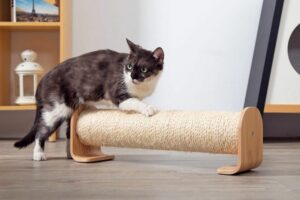It is known that cats enjoy scratching due to many different influences. During this process, unnecessary damage may be caused to items in the home such as furniture, chairs, drapes, and carpets – a cat owner’s dreaded nightmare. This article will help the cat owner understand why cats scratch and how to deal with the persistent issue at hand.

Why do cats scratch?
Cats scratch for many different reasons and it is a normal species behavior. Normal scratching behavior may include scratching during play, while stretching, to mark territory, to groom claws, when they are excited, stressed or anxious, and to send threatening signals to other cats. Although there are also abnormal scratching behaviors such as scratching humans or other animals. Veterinary attention should be sought if abnormal scratching behavior is occurring.


The statistics:
Feline destructive scratching is very common. About 60% of cat owners will complain about destructive scratching in the home, although most owners will not bring this issue up with their veterinary team or seek behavioral treatment.
Unfortunately, the longer the issue persists the more difficult it is to treat the unwanted behavior.
Some owners will relinquish their cat when they are fed up with inappropriate scratching, not allow their cats inside (which can lead to vehicle trauma, fights with other cats, viral diseases among other concerns), or consider declawing (which is now illegal in Ontario unless deemed medically necessary).
The good news is that there is a solution to the above stated problems. Follow along to discover tips and tricks to save your furniture while maintaining a loving bond between you and your feline companion!
What can be done about feline destructive scratching?
- Offer appropriate scratching posts and catnip to intrigue them (May need to try multiple different surfaces as some cats may have preferences)
- Keep nails trimmed! This will not stop the scratching behavior although it will assist in maintaining nail health
- Use plastic nail caps. Nail caps are very humane and they do not stop scratching but eliminate the damage caused by scratching. The downside is that sometimes they can be difficult to apply and may not last very long as they will need to be replaced every 4-6 weeks.
- Use a pheromone spray to encourage scratching on appropriate surfaces (Ex. Feliway)
- Limit your cat to a safe/enclosed outdoor area (Ex. cattery or enclosure)
Punishment for scratching can damage the human-animal bond. This can lead to increased anxiety/aggression. This approach is unlikely to be effective at eliminating scratching.


Why declawing is not an appropriate solution to scratching
Declawing cats is a very controversial subject. There are many cat owners who believe that declawing cats is an easy, one time procedure. Although, what most do not realize is that declawing is actually an amputation of the first joint on every single toe (typically this would be 10 amputations). Many complications can also arise from this surgery such as infection, regrowth of claws, hemorrhage, and chronic pain if performed improperly. There is also no benefit to the cat in performing this procedure.
It is best to teach the cat appropriate scratching habits
- Prevent access to the unwanted scratching area or make it unappealing
- Confine cat to 1 room (this can be especially good for training kittens)
- Cover the furniture with plastic or double sided tape
- Use feliway (this is a pheromone spray that will enforce the behavior that the cat has already marked on the surface and does not need to again).
- Positively reinforce desired behavior
- Direct cat towards appropriate scratch object (Ex. Pick cat up, use feather toy to direct them)
- Most cats seem to enjoy a rope covered post but all cats have different preferences. Try using a different substrate if rope does not work
- Other good examples are cardboard, fabric or carpet.
- Position the post properly and make sure it is stable.
- Place the post somewhere easy to get to.
- Facial marking brushes on corners are good ideas.
If you have any questions after reading this article please feel welcome to reach out to our friendly fear free certified staff anytime! We would be more than happy to assist you in learning more, please call us at 519-893-8937 or send us an email at [email protected].


